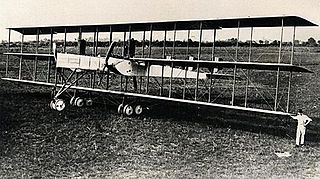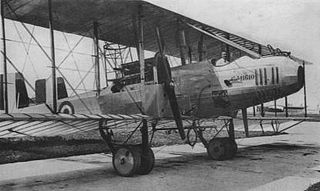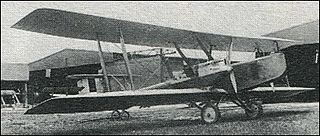
The Caproni Ca.3 is an Italian heavy bomber of World War I and the postwar era. It was the most produced version of the series of aircraft that began with the 1914 Caproni Ca.1 and continued until the more powerful 1917 Caproni Ca.5 variant.

The Caproni Ca.4 was an Italian heavy bomber of the World War I era.

The Caproni Ca.1 was an Italian heavy bomber of the World War I era.

The Caproni Ca.5 was an Italian heavy bomber of World War I and the postwar era. It was the final version of the series of aircraft that began with the Caproni Ca.1 in 1914.

The Caproni Ca.37 was a ground attack aircraft designed and built in Italy by Caproni around 1916

The Caproni Ca.165 was an Italian biplane fighter developed just before World War II, but produced only as a prototype, as the competing Fiat CR.42 Falco was selected for series production.

The Caproni Ca.97 was a civil utility aircraft produced in Italy in the late 1920s and early 1930s. As originally designed, it was a high-wing braced trimotor monoplane of conventional configuration with one engine mounted on the nose and the other two carried on strut-mounted nacelles at the fuselage sides. Examples were also produced with only the nose engine or only the two nacelle-mounted engines.

The Pomilio PE was a First World War Italian armed reconnaissance biplane designed and built by the Pomilio brothers. It was developed from the earlier Pomilio PC and PD.
The Grahame-White Ganymede was a prototype British heavy night bomber intended to serve with the Royal Air Force in the First World War. A large, three-engined, twin-boom biplane, the sole prototype Ganymede did not fly until after the war had ended, and although an attempt was made to convert the aircraft to an airliner, it was unsuccessful.
The Savoia-Pomilio SP.2 was a reconnaissance and bomber aircraft built in Italy during the First World War. It was a refined version of the SP.1, and like it, took its basic configuration from the Farman MF.11: a biplane with twin tails and a fuselage nacelle that accommodated the crew and a pusher-mounted engine. The SP.2 entered mass production with SIA, and with co-designer Ottorino Pomilio's own firm that he had recently established.

The Piaggio P.3 was an Italian night bomber prototype built by Piaggio in 1923.

The Siemens-Schuckert L.I was a large, three-engined biplane bomber aircraft, built in Germany towards the end of World War I. It was a twin boom design, strongly influenced by the successful Caproni Ca.3. Three were built but not used operationally.
The Caproni Ca.61 was an Italian heavy day bomber aircraft of 1922. It was the final development of the Caproni three engine, twin boom biplane types developed during World War I, but it was not put into production.
The Caproni Ca.66 was an Italian night bomber designed to reequip the post-World War I Italian Air Force. Only two examples of the four-engined biplane were built.
The Henri Farman HF.35 was a large 3-seat biplane designed and built in France by Henri Farman during 1915.
The Caproni Ca.134 was a biplane reconnaissance aircraft built by the Italian company Caproni in the 1930s.

The Caproni Ca.7 was a proposed biplane designed by Caproni in the early 1910s.
The Caproni Ca.66 and Caproni Ca.67 were Italian night bomber aircraft designed to re-equip the post-World War I Regia Aeronautica.
The Caproni Ca.103 was a biplane twin-engine bomber developed by the Italian company Aeronautica Caproni in the late 1920s.

The Caproni Ca.53 was an Italian prototype light bomber built in the last months of World War I.












